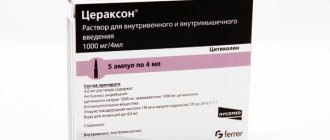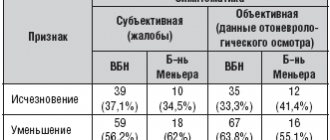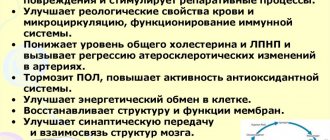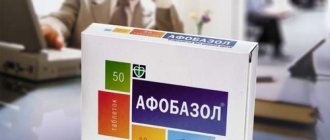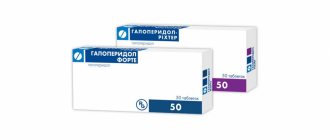Pharmacological properties of the drug Ceraxon
Citicoline stimulates the biosynthesis of structural phospholipids in neuronal membranes, which improves membrane function, including the functioning of ion exchange pumps and neuroreceptors. Due to its stabilizing effect on the membrane, citicoline has anti-edematous properties and reduces cerebral edema. Citicoline reduces the severity of symptoms of cerebral dysfunction after pathological processes such as traumatic brain injury or acute cerebrovascular accidents. Citicoline reduces the level of amnesia, improves the condition of cognitive, sensory and motor disorders, and also weakens the severity of symptoms that are observed with hypoxia and cerebral ischemia, including memory impairment, emotional lability, and impaired ability to perform normal self-care activities. Citicoline is a natural compound found in the human body, so classical pharmacokinetic studies cannot be performed due to the difficulty of quantifying exogenous and endogenous citicoline. During a pharmacokinetic study, its almost complete absorption in the gastrointestinal tract was determined - less than 1% of the dose taken was detected in the feces within 5 days after taking the drug. Two peaks of radioactivity were also noted in the blood plasma, due to metabolism in the liver and intestines: the first - after 1 hour, the second - after 24 hours. Bioavailability by oral and parenteral routes of administration is almost the same. Excretion is very slow, mainly through the respiratory system and urine. After 5 days of administration, about 16% of the drug dose was detected, which indicates the inclusion of the rest of the dose in metabolic processes.
Comparison of safety of Cerakson and Naypilept
The safety of a drug includes many factors.
At the same time, in Cerakson it is quite similar to Neypilept. It is important where the drug is metabolized: drugs are excreted from the body either unchanged or in the form of products of their biochemical transformations. Metabolism occurs spontaneously, but most often involves major organs such as the liver, kidneys, lungs, skin, brain and others. When assessing metabolism in Cerakson, as well as in Neypilept, we look at which organ is the metabolizing organ and how critical the effect on it is.
The risk-benefit ratio is when the prescription of a drug is undesirable, but justified under certain conditions and circumstances, with the obligatory observance of caution in use. At the same time, Ceraxon does not have any risks when used, just like Neypilept.
Also, when calculating safety, it is taken into account whether only allergic reactions occur or possible dysfunction of the main organs. In other matters, as well as the reversibility of the consequences of using Cerakson and Neypilept.
Use of the drug Ceraxon
The solution for oral use in adults is prescribed 200 mg (2 ml) orally 3 times a day. For children, the drug can be prescribed orally from the moment of birth - 100 mg (1 ml) 2-3 times a day. The duration of treatment depends on the severity of the brain damage. The minimum recommended period is 45 days. The dose of the drug and the duration of treatment can be changed by the doctor. The drug, pre-mixed with a small amount of water, is taken using a dosing syringe. It is necessary to rinse the dosing syringe with water after each use. IV or IM administration In acute and emergency conditions, the maximum therapeutic effect is achieved when the drug is administered in the first 24 hours. IV is administered slowly (injection duration - 5 minutes) or drip (infusion rate - 40-60 drops per minute) . Treatment begins with prescribing the drug for the first 2 weeks, 500–1000 mg (depending on the patient’s condition) 2 times a day intravenously. Then - 500–1000 mg 2 times a day IM. The maximum daily dose is 2000 mg. If necessary, treatment is continued with the drug in the form of an oral solution. The recommended duration of treatment, at which the maximum therapeutic effect is noted, is 12 weeks. It is recommended for children to prescribe Ceraxon in the form of a solution for oral use.
Comparison of addiction between Cerakson and Neypilept
Like safety, addiction also involves many factors that must be considered when evaluating a drug.
So, the totality of the values of such parameters as “o syndrome” in Cerakson is quite similar to the similar values in Neypilept. Withdrawal syndrome is a pathological condition that occurs after the cessation of intake of addictive or dependent substances into the body. And resistance is understood as initial immunity to a drug; in this it differs from addiction, when immunity to a drug develops over a certain period of time. The presence of resistance can only be stated if an attempt has been made to increase the dose of the drug to the maximum possible. At the same time, in Tserakson the meaning of the “syndrome” is quite small, however, the same as in Neypilept.
Special instructions for the use of the drug Ceraxon
There are no age restrictions for oral use of the drug. Pregnancy and lactation Although no evidence of risk to the fetus has been obtained when using the drug, during pregnancy the drug is used only when the expected benefit outweighs the potential risk. There are no data on the passage of citicoline into breast milk and its effect on the fetus is unknown. Effect on the ability to drive vehicles and operate complex mechanisms. Citicoline does not affect the ability to drive vehicles and operate complex mechanisms.
Comparison of the effectiveness of Ceraxon and Neypilept
The effectiveness of Ceraxon is quite similar to Neypilept - this means that the ability of the drug substance to provide the maximum possible effect is similar.
For example, if the therapeutic effect of Ceraxon is more pronounced, then using Neypilept even in large doses will not achieve this effect.
Also, the speed of therapy - an indicator of the speed of therapeutic action - is approximately the same for Ceraxon and Neypilept. And bioavailability, that is, the amount of a drug reaching its site of action in the body, is similar. The higher the bioavailability, the less it will be lost during absorption and use by the body.
Comparison of side effects of Ceraxon and Neypilept
Side effects or adverse events are any adverse medical event that occurs in a subject after administration of a drug.
Cerakson's level of adverse events is almost the same as Neypilept's. They both have few side effects. This implies that the frequency of their occurrence is low, that is, the indicator of how many cases of an undesirable effect of treatment are possible and registered is low. The undesirable effect on the body, the strength of influence and the toxic effect of Ceraxon are similar to Neypilept: how quickly the body recovers after taking it and whether it recovers at all.
Ceraxon tablets: composition and action
Ceraxon is sold in several forms:
- injections;
- pills;
- solution for systemic use.
The tablets contain the main active ingredient – citicoline sodium. In addition to this, the composition includes:
- talc;
- castor oil;
- magnesium stearate.
Tablets are packed in 5 pieces in a blister, each box contains 4 blisters. The solution intended for drinking contains the same basic substance - citicoline, and along with it glycerin, sorbidol, sodium citrate, sodium saccharinate, strawberry flavoring. This composition is packaged in unpainted glass bottles with plastic caps. The volume of one bottle is 30 ml. It is convenient to dose using the syringe included in each package.
The drug for administration into a vein is packaged in glass ampoules, with a break line marked. One cardboard package can contain 3 or 5 pieces. Ceraxon mainly acts on brain cells, strengthening membranes, improving the functions of ion exchange pumps of the nervous system, which is due to the production of phospholipids.
In case of severe swelling, the action of the drug relieves pressure at the site of the lesion, which returns the cognitive functions of the brain. In addition, the ability to concentrate is restored and memory improves. If Cerakson is applied promptly at the first symptoms of a stroke, it will be possible to minimize the area of spread of necrotic tissue.
Citicoline is one of the constant elements of the human body, which does not make it possible to evaluate its pharmacokinetics. The substance entering through the gastrointestinal tract is absorbed almost completely. As a rule, 1-2% of the total ingested volume remains unabsorbed. Citicoline is excreted through the kidneys in the urine.
As a result of hepatic metabolism processes, two substances are formed: cytidine and choline. Citicoline is first concentrated in the structures and tissues of the brain. At the same time, fractions of the resulting choline pass into phospholipids, and cytidine derivatives into the composition of nucleic acids.
Contraindications for use
If, as a result of diagnosing the patient’s condition, the following features are revealed, Cerakson is not prescribed:
- individual intolerance to one of the components of the drug;
- tone of the autonomic nervous system, in its parasympathetic part;
- hereditary fructose intolerance.
Adverse reactions during treatment with Cerakson are extremely rare, among them are:
- coordination problems;
- pain in the occipital region;
- diarrhea;
- appetite disorders;
- insomnia;
- rash.
Sometimes short-term changes in blood pressure are observed, as well as loss of sensation, mainly in the arm and leg on the paralyzed side, if the patient has suffered a stroke.
If any of these reactions occur, you should discuss changing the course of therapy with your doctor.
Buy Ceraxon solution intravenously and intramuscularly 500 mg 4 ml No. 5 in pharmacies
The solution for intravenous and intramuscular administration is a clear, colorless liquid. Indications : acute period of ischemic stroke (as part of complex therapy); — recovery period of ischemic and hemorrhagic strokes; — traumatic brain injury, acute (as part of complex therapy) and recovery period; — cognitive and behavioral disorders in degenerative and vascular diseases of the brain. Dosage regimen IV drug is administered as a slow injection (over 3-5 minutes, depending on the prescribed dose) or drip infusion (40-60 drops/min). The intravenous route of administration is preferable to the intramuscular route. When administered intramuscularly, repeated administration of the drug in the same place should be avoided. Acute period of ischemic stroke and traumatic brain injury: the recommended dose is 1000 mg every 12 hours from the first day after diagnosis; Duration of treatment is at least 6 weeks. 3-5 days after the start of treatment (if swallowing function is not impaired), it is possible to switch to oral forms of the drug Ceraxon®. Recovery period for ischemic and hemorrhagic strokes, recovery period for traumatic brain injury, cognitive and behavioral disorders in degenerative and vascular diseases of the brain: the recommended dose is 500-2000 mg/day (5-10 ml 1-2 times/day). The dose and duration of treatment depend on the severity of the symptoms of the disease. Elderly patients do not require dose adjustment of Ceraxon® for intravenous or intramuscular administration. A solution for intravenous and intramuscular administration in an ampoule is intended for single use. After opening the ampoule, the solution should be used immediately. The drug is compatible with all types of intravenous isotonic solutions and dextrose solutions. Side effects Very rare (<1/10,000) (including individual cases): allergic reactions (rash, itching, anaphylactic shock), headache, dizziness, feeling of heat, tremor, nausea, vomiting, diarrhea, hallucinations, swelling, shortness of breath , insomnia, agitation, loss of appetite, numbness in paralyzed limbs, changes in the activity of liver enzymes. In some cases, Ceraxon® can stimulate the parasympathetic system and also cause a short-term change in blood pressure. If any of the side effects indicated in the instructions get worse, or any other side effects not listed in the instructions are noticed, you should inform your doctor. Contraindications for use : severe vagotonia (predominance of the tone of the parasympathetic part of the autonomic nervous system); - children and adolescents under 18 years of age (due to the lack of sufficient clinical data); - hypersensitivity to the components of the drug. Use during pregnancy and lactation There is not enough clinical data on the use of citicoline during pregnancy. Although experimental studies on animals have not revealed any negative effects, during pregnancy the drug is prescribed only when the expected benefit of therapy for the mother outweighs the potential risk to the fetus. If it is necessary to use the drug during lactation, the issue of stopping breastfeeding should be decided, since there is no data on the excretion of citicoline in breast milk. Use in children Contraindicated in children and adolescents under 18 years of age. Use in elderly patients Elderly patients do not require dose adjustment of Ceraxon®. Special instructions Impact on the ability to drive vehicles and operate machinery During the treatment period, patients should be careful when performing potentially dangerous activities that require special attention and speed of psychomotor reactions (including driving a car and other vehicles, working with moving mechanisms, work of the dispatcher and operator). Overdose Due to the low toxicity of the drug, cases of overdose have not been described. Drug interactions Citicoline enhances the effects of levodopa. Ceraxon® should not be prescribed concomitantly with medications containing meclofenoxate. Conditions and periods of storage The drug should be stored out of the reach of children at a temperature not exceeding 30°C. Shelf life: 3 years. Conditions for dispensing from pharmacies The drug is dispensed with a prescription.
When is Cerakson prescribed?
Treatment with Ceraxon is indicated in the following cases:
- first 4 hours during primary stroke;
- for rehabilitation after a stroke;
- emergency assistance and to restore the condition impaired as a result of severe head injury;
- cerebrovascular diseases that reduce cognitive function and provoke behavioral changes.
If the patient was administered Ceraxon in the first hours after a traumatic brain injury, the duration of post-traumatic coma will be less than without the help of the drug. In addition, there is a high probability of reducing the severity of neurological abnormalities typical of this type of injury.
If chronic hypoxia has become the reason for the predominance of lack of initiative in a person’s behavior, complete inability in matters of self-care, the drug effectively affects certain areas of the brain, restoring cognitive functions.
